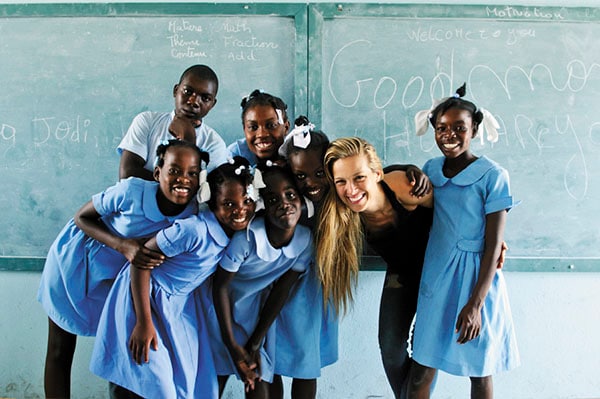Head (and heart) over high heels for supermodel Petra Nemcova
Petra Nemcova, a Czech supermodel who survived the 2004 tsunami, is helping rebuild the lives of disaster-hit children


On the morning after Christmas in 2004, Petra Nemcova was wrapping up her perfect Asian holiday in Thailand’s Khao Lak to return to her flourishing modelling career in the US. One last stroll on the idyllic beach with her partner Simon Atlee, a British fashion photographer, turned out to be quite unremarkable, except that she noticed that the sea had receded a fair bit. Nature’s whims and fancies, she might have wondered then. But once the duo returned to their beach bungalow and were packing to leave, they knew why. By then, the sea bed had heaved, releasing the energy of 23,000 Hiroshima-type atom bombs and unleashing a groundswell of water known as the tsunami.
Within moments, towering tidal waves crashed into their room, bringing it down like a house of cards. Amidst screaming holidayers and the deafening rumble of the waves, Nemcova, then 25, tried to cling on to the roof of another bungalow. She hoped Atlee would do better since he was a strong swimmer. But as the rubble slammed against her hips and legs, shattering her pelvis and giving her severe internal injuries, she lost sight of both Atlee and hope.
Nemcova was to know later that this was indeed the moment she had lost Atlee. His body was washed up on a beach several months later, one among the over 200,000-odd that the raging waters killed that day.
As for her, Nemcova had just about managed to haul herself up on to the roof she was holding on to, when a second wave lashed in. As it pulled her out into the Andaman Sea, she stuck out her arms to hold on to anything she could. It happened to be a palm tree. And that’s how she stayed for eight hours, flitting in and out of consciousness. Gradually, as the water retreated, Nemcova was lowered onto a pile of debris, where she lay till she was rescued by two Thai men.
“When I was in the water, the hardest part was not the pain and injuries I suffered, but hearing children screaming for help. After half an hour, the screams stopped, which meant they were washed away into the sea. I felt a horrible sense of helplessness of not being able to do anything. At that point, I had no choice. Now, I do,” says the supermodel-turned-Samaritan.
Choice is a key word in Nemcova’s lexicon. Perhaps because while growing up in Karviná, a small coal-mining town in communist Czechoslovakia, choice, or the lack of it, defined everyday life in the 1980s. When the Velvet Revolution brought the regime down in 1989 and afforded Nemcova the freedom to choose a profession, she turned to fashion.
“My mum had taught me to sew since the age of 11, so it was a profession close to my heart. Under the [communist] regime, we had restrictions on everything—from travelling to choosing a profession. But the minute the choices opened up, I took that to be a ticket to empower myself and my family,” she says. “Even now, with my jet-setting lifestyle [she reached Mumbai from Paris and was to take off for Los Angeles in three days], I feel I am making up for all that my family missed.”
In 1996, Nemcova took baby steps into the world of modelling, winning the Czech Elite Look of the Year contest and travelling to Nice, France, to participate in the international event. She didn’t win the crown, but Nice provided a launch pad for her aspirations. Returning to the Czech Republic to finish her schooling, Nemcova went off to work in Milan when she turned 18. From then on, her career has been on an upward trajectory.
When she debuted in Sports Illustrated’s prestigious annual swimsuit special, she had not even heard of the magazine. “Who would believe that a magazine I never heard of, an American sports magazine, would catapult me to modelling stardom?” Nemcova writes in her autobiography Love Always, Petra. But the zenith of her storied career came in 2003 when she achieved the Holy Grail of modelling: Featuring on the cover of the swimsuit edition and joining the league of modelling greats like Cindy Crawford and Heidi Klum. She was later included in Sports Illustrated’s list of ‘25 Legends Of Swimsuit’, published to mark their 50th anniversary in 2014.
It was at a time, in 2004, when Nemcova’s professional life was at its peak that the tsunami struck. But, more than a decade later, seated at a corporate office in suburban Mumbai, the 2004 Miss Universe judge doesn’t flinch while talking about the tragedy. Perhaps she’s grown accustomed to the repeated questions about it. Or perhaps because having gone through the ordeal, she realises “how fleeting life is and every day that I live now, gives me a high”. With a half-smile and clasped hands, she reveals the gritty journey she took on in the days after, many of which she spent in hospitals, first in Thailand and later in Prague. “The doctors told me I had an extraordinary pace of recovery that patients with injuries like mine take about two years to recover. For me, much of the recovery was through the power of my mind,” says Nemcova. In May 2005, five months after she had left Thailand, she went back to the country with her sister Olga and a few friends. And what she saw saddened her immensely.
Typically, rescuers swoop down on an area with aid in the immediate aftermath of a natural disaster. But they begin to leave after a few months, sending the stricken communities back into their despair and deprivation. That is what had happened in Thailand when Nemcova went back: The first responders had gone away, leaving behind gaping physical and emotional scars.
Empty shells of what once used to be homes, schools and hospitals were splattered all over worst affected were the children, with “blank looks on their faces.”
It was around then that Nemcova, recalibrated her life’s priorities from fashion to philanthropy. “So, a friend of mine and I decided to rebuild a school in Khao Lak. We sat down on our knees and drafted everything from scratch—from fixing contractors to making brochures to organising fundraisers... everything.”
It was also at that time that Nemcova founded the Happy Hearts Fund (HHF), an NGO to rebuild resilient schools for children in affected areas and conduct rehabilitation work during gap periods, “a time when the first responders leave and it’s no more sexy enough to work in disaster-hit areas”. She observed that it takes about four to six years to rebuild schools in areas hit by natural disasters. “Four to six years is the entire duration of primary education. If it takes that long, an entire generation misses out on proper primary education,” says Nemcova.
Over 10 years, HHF has raised $15 million to rebuild 118 safe, resilient schools, benefiting over 50,000 children in nine countries, including Thailand, Indonesia, the Philippines, Mexico and Peru. Soon, HHF will expand its footprint to a 10th country, Nepal, where a 7.9-magnitude earthquake this April killed about 9,000 people. The funds required to set up each school varies from country to country: While a school with two to three rooms and a playground in Indonesia can be set up for $50,000, a bigger school in Peru may cost up to $350,000. “My father was a construction worker building homes for people and I am building schools for children. In a way, it’s funny,” she says. HHF works with its partner organisations to zero in on an area that is most in need of help, least likely to be funded, and most keen to engage, and hands out the work to local contractors through a bidding process. Apart from being a professional model, Petra Nemcova is also Haiti’s ambassador-at-large. Here, she is seen with Haitian students
Apart from being a professional model, Petra Nemcova is also Haiti’s ambassador-at-large. Here, she is seen with Haitian students
One of HHF’s immediate goals is to scale up its construction work. But, over the long term, it is looking to create a sustained impact by “narrowing the gap” to 1-2 years. “The longer the kids have to wait to return to school, the more traumatic it is for them,” says Nemcova. She feels that the faster the essential physical structures of a community—schools, hospitals, homes—are set up, the easier it is for the people to pick themselves up. The NGO has several corporate tie-ups as well as fundraising galas, “but raising money is always a challenge”, says Nemcova. “It’s particularly a problem with me because I don’t like to ask people for money. But so many schools need rebuilding that we always have to look for engaging and innovative ways to get money. That’s when I tell donors our stories.”
“Petra, along with the HHF team, board and partners, is actively involved in rebuilding safe-resilient schools. She is constantly using her ideas and her network to take the organisation to the next level,” says Ellie Manko Libby, the director of development at HHF. Earlier this month, Nemcova had come to Mumbai for the Code for Good event, JP Morgan’s global flagship programme that brings together college students to devise creative technological solutions to real-world challenges faced by non-profit organisations.
Nemcova remains a professional model, and also plays the role of Haiti’s ambassador-at-large. She has turned entrepreneur with her Be The Light New York line of candles. But philanthropy remains her priority. We know the fashionista has a fetish for hats, but how does she slip on four with such ease? “I don’t sleep much. I love what I am doing. And I meditate. That helps me focus and multitask… And having four roles ensures I am never bored with just one.”
Nemcova finds validation of her work in the unbridled joy of children and an outpouring of gratitude from the teachers every time a school is inaugurated. But it’s the words of a teacher in Mexico that have stuck for good: “There are so many things that you can measure... how many children you have helped, how many community members you have rescued. But there are so many things the school has done for the fabric of the family and the community that can never be measured.”
First Published: Aug 04, 2015, 06:34
Subscribe Now